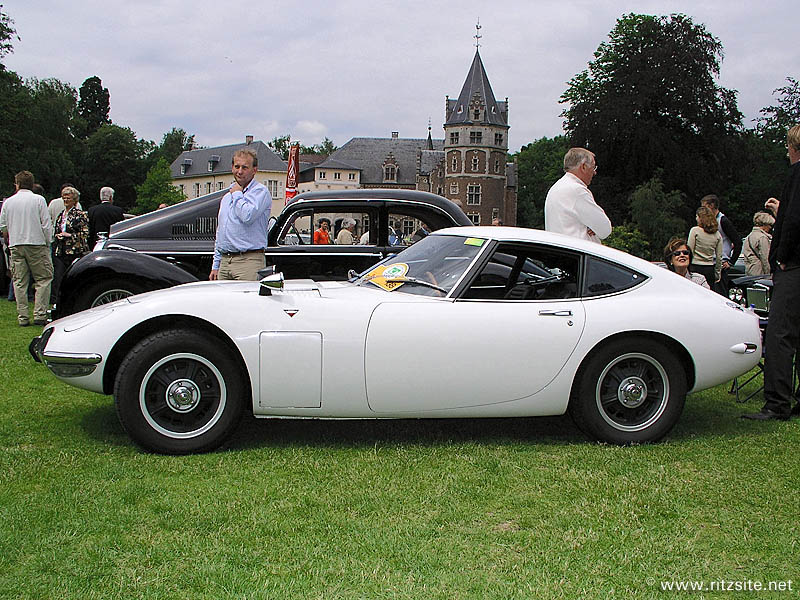|

Toyota 2000 GT - coupe body - manufactured in 1968
Classic Japanese cars are quite unusual in Europe but there are a few that have acquired a special place in the hearts of European car enthusiasts. Most prominent of those is without a doubt the wonderfully exotic Toyota 2000 GT. This elegant sports car was brought to the attention of the Western world by featuring in the James Bond movie "You only live twice" which appeared in 1967. In this movie, in which remarkably the hero doesn't drive any car himself, a special convertible version of the 2000 GT was used in a number of scenes. In reality a convertible was never offered, but there was a coupe which was sold from 1967 till 1970. It wasn't a commercial success with only 342 cars sold of which 86 were exported but it was a great banner for the growing importance of the Japanese car industry in the world. The 2000 GT was a serious and up-to-date car marking the shift from producing cheap copied cars with obsolete technology to modern cars of equal quality to what's produced in Europe and the US.
Still, there was an important amount of "copying" involved in the development of the 2000 GT, which is understandable if you have to catch up on experience and technology. In some aspects this car can be seen as a proof of competence for Japanese engineering at the time. This wasn't a car for the masses but one that was aimed to show that Japanese engineering was in fact capable to put a car on the road that could hold its own in the illustrious premium sports car segment, both on and off the racing track. Development of the 2000 GT was started in 1963 and though it was a completely original design it leaned heavily on experience gathered from analyzing cars like the Lotus Elan and the Jaguar E-type. Clear influences of the Elan can be found in the design of the 2000 GT's backbone chassis and also in that of its interior. The lines of the E-type can be recognized in the shape of the bodywork of the 2000 GT, though it's more petite. In this case however the copying doesn't really offend, it has clearly been done in the best possible taste and with endearing effort.
The 2000 GT was actually built for Toyota by Yamaha, the motorcycle and piano manufacturer, which had also constructed a 2000 GT prototype designed by Albrecht Goertz for Toyota's rival Nissan (Datsun) in 1964. This way the misconception was born that Goertz, the well-known German designer responsible for beautiful cars like the BMW 507, had designed the Toyota 2000 GT. This isn't true, Toyota's 2000 GT design was by the hand of Japanese designer Satoru Nozaki. Engine-wise the 2000 GT boasted an important novelty for Toyota: the car was powered by the company's first double overhead camshaft (DOHC) engine. It was a 6-cylinder in-line unit displacing 1988 cc and producing 150 hp @ 6600 rpm in standard trim. At a relatively limited weight of 1090 kg it proved to be quite a quick car with a maximum speed of 206 kph and thanks to a favorable weight distribution it also handled well.
There was also a racing version of the 2000 GT. This version only weighed 885 kg and had 200 hp @ 7200 rpm, enough for a top speed of over 250 kph. Carroll Shelby's team, after their famous association with Ford went sour, raced cars like these during the 1968 season in the group C production car class at the SCCA races in the US and scored a second and third place in the standings at the end of the season in that class. Shelby saw potential in the car but Toyota decided to pull the plug on the whole project after 1968 because sales in the US remained extremely low. Other racing successes of the 2000 GT were limited to Japan.
The biggest problem of the Toyota 2000 GT was its substantial price. It was more expensive than a contemporary Jaguar E-type or Porsche 911 S and yet it lacked the image and heritage of cars like these. So as a result it was almost impossible to sell it outside Japan and within Japan there was not much of a market for it. After a short and unsuccessful spell with a larger, 2300 cc engine in the 2000 GT during 1970, Toyota decided to stop producing this model and let the new, simpler and more affordable Celica model hold its sports car crown. And almost at the same time the Toyota 2000 GT was rapidly obscured by the Datsun 240 Z, a quite similar car marketed far more efficiently and which took the sports car market by storm during the early 1970s.
Never the less the Toyota 2000 GT is nowadays a sought after classic which is far more valuable than a Datsun 240 Z, largely because it's so exotic and pretty. It's not easy to find one however; there are very few around in Europe. Therefore it's always a nice and rare surprise to encounter one on the road or at a car show.
If you want to know more about this car you can visit this extremely elaborate Toyota 2000 GT site by a Swiss enthusiast (site is in French).
© André Ritzinger, Amsterdam, Holland
|
